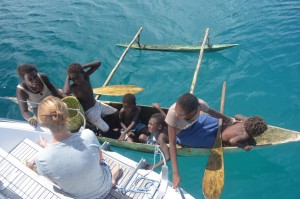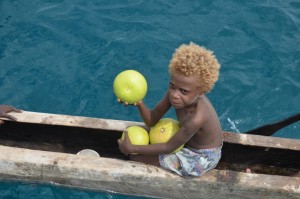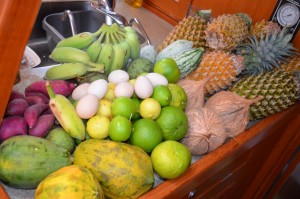Trading in the South Pacific
We found trading a great way to engage with the local people living on many of the islands we stopped at in the South Pacific. In the more remote islands trading with yachts has become a way for these people to source supplies they need but can’t access. It is also a way for yachts to source fresh fruit and vegetables; at times we would be several weeks between main towns and therefore relied upon trading for our fresh supplies.
Our trading started in some of the remote islands in the east of Fiji, continued throughout Vanuatu and became a part of our everyday life in the Solomon Islands and Papua New Guinea (PNG). People would paddle out to Adina with fresh produce from their garden, whatever was in season at the time. In the Solomon Islands people also wanted to trade carvings and woven baskets and bags. At some islands we were able to “order” crayfish for trading. Sometimes we traded as we walked through villages. We never went short of fresh fruit and vegetables!
How we went about trading
We always tried to make sure we traded fairly, giving back equivalent or more than we were being given. We looked at prices in shops and at the fresh market at the first town we arrived at in each country to gauge this. For example, in the Solomons we saw that a kilo of rice or flour cost around SBD15, whilst bundles of vegetables at the market were either SBD5 or 10 depending on the size of bundle. So if we were given a decent bundle of two or three different vegetables together we knew it was worth at least one kilo of rice.
We always traded with the first person to come to the boat in each place we anchored, even if we did not need or want what they offered. We felt this was the right way to start our relationship with the village.
We always asked the trader what they would like in return. In some places they would simply say “it’s up to you” and in others they would be specific. If we had what they wanted we would give it. Sometimes this would mean we’d give them more than they’d asked for to ensure we gave a fair trade whilst others might get lucky, for example getting a t-shirt for a bunch of bananas. For the shy, we would prompt them with the types of things we had and if they still wouldn’t say what they wanted we’d tend to give them rice and corned beef as we knew these were favoured items.
We would tell traders if there was anything we were looking for, to see if they had it or anyone else in the village did, emphasising the need for small portions “as we are only two people”. In the Solomons we often asked for eggs and found that people wanted money rather than a trade, which was fine by us.
We always traded with children regardless of what they brought us. Sometimes this would be a pair of coconuts, a few oranges or as extreme as twelve papayas and a bird as we experienced at one anchorage! If the children brought a lot of produce, clearly from their parents’ garden, we’d give something for them (biscuits, a ball, hair bands) and something for them to take to their parents (rice, corned beef). If there were lots of children in the canoe together bringing a small offering, such as a couple of coconuts between them, we’d give them a packet of biscuits to share. Unfortunately some children would throw biscuit packaging in the sea despite us asking them not to so we started asking for the packaging back or gave the biscuits out one by one to each child to avoid giving packaging at all. Another yacht we met said they made popcorn when there were many children coming to visit, but had the same issue with the plastic bags they used to distribute it. We found children the most entertaining traders, some returning multiple times with different produce to see what goodies they could get from us! In many places children were asking for pencils and exercise books for their school work which we happily gave.
Occasionally we did say no to adult traders. In some anchorages we were inundated and it would have been mad to trade for everything that was offered. In these instances we would politely tell the trader we already had more than enough, thank them for coming to see us and ask them to tell others we now had enough of the fruit or vegetable in question. We would also tell them if there was anything else we were keen to trade for.
Making “tok-tok”. Some traders would come to the boat and simply want to trade, paddling straight back to the village. Others would want to stay and chat, or float a little way off Adina just watching us work or looking at things on the yacht. We never had a problem with this as we found people generally to be very well meaning and simply inquisitive. We would always make time to talk -you are curious about them, you should expect them to be curious about you and talking is an important part of life to the islanders.
We found that certain items would become popular in a particular village. For example, we would trade children’s pants with one person and half an hour later have two more
canoes at the boat asking to trade for pants too – it was as if word had got out that we had pants on board!
Packaging is precious! If someone gave us their produce in a plastic bag, no matter how small, we always emptied it and gave it back to them. Bags of any size are valuable in remote islands! We often gave our trade in a bag to ensure it would get to shore still dry. And we gave the larger rice/flour sacks away – these are valuable items for transporting produce from the gardens and in some places are made into shoulder bags and school bags.
We would always carry a few items for trading in our rucksack when we went ashore to enable us to trade if we met someone with vegetables. These items also doubled as potential gifts to give to a chief if it was our first time going in to the village.
Save some things for the next village. We found some villages would quite happily have traded until we were empty but you always have to think there is another village ahead and people there who will also be desperate to trade with you. So be careful and save trading goods for throughout your trip.
Trading and not just giving. We followed this rule as we believe giving alone sets a bad precedent as islanders will then expect the next yacht to do the same and in time it could cause problems. Similarly we learnt not to hand things over for a trade on the expectation of the person returning with their trade as the few times we did it, they never returned. That said, we had a golden rule that if anyone genuinely needed medicine or school material we would happily give it to them.
What we traded
We carried a selection of items purchased specifically for trading. At times we also traded from items we had on board for ourselves. The list below is exhaustive; we’ve annotated the most popular items with stars.
Food items:
Rice*
Sugar*
Flour
Tea bags
Coffee
Corned beef tins*
Salt
Powdered milk
Sweet biscuits*
We would bulk buy rice, flour and sugar in sacks and re-bag into one kilo bags. Over the first three months of the 2015 season when we spent time in north Vanuatu, Solomon Islands and east Papua New Guinea we traded approximately 60kg of rice, 15kg of flour and 10kg of sugar. We could have traded more sugar if we had been carrying it. To try to avoid issues with weevils we bought the sacks of rice and flour at main towns as we went along, rather than buying it all at the start of the season.
Household items:
Washing powder for clothes*
Matches
Cutlery
Cooking utensils (wooden)
Plates, bowls and mugs (plastic)
Stationery:
Biros
Colouring pencils*
Pencils*
Pencil sharpeners
Exercise books*
Fishing materials:
Small hooks for trolling when paddling a canoe*
Medium hooks for trolling from a banana boat
Fishing line*
Small plastic squids (called “bait” in many islands)
Toys for children:
Small bouncing balls*
Skipping ropes
Hair bands (in pretty colours)*
Small toy cars
Swimming goggles*
Balloons
Bubble blowers
Clothing:
Ladies t-shirts, shorts (to the knee) and sarongs*
Men’s t-shirts and shorts
Children’s pants, t-shirts and shorts*
Flip-flops
Small bottles of perfume for the ladies
We had a mixture of new and pre-warn clothes; people were perfectly happy to trade pre-warn clothes in good condition. We’d agree with the trader what type of clothing they wanted then show them a few options in about the right size to allow them to choose. This was particularly pleasing to the girls and children!
Solomon Islands only, for carvers:
Sandpaper of all grades*
Superglue*
Wood glue
Carving tools
Carving is big business in the Solomon Islands and we found these items to be things the carvers really wanted and actually seemed to expect yachts to be carrying to trade with them. We found we were able to negotiate combined money/trading item deals for the carvings we wanted.
Sourcing items for trading
Whilst the list above looks long, we found just a few trips to different shops enabled us to set ourselves up. We then topped up in main towns along the way if we needed to.
We bought clothing in budget stores in New Zealand. We bought food items in bulk from wholesale shops to get the best prices – BonMarche Wholesale in Port Vila, Vanuatu was our main source for this. The rest of the non-food items we bought from Chinese shops in Port Vila, similar to those you find in many main cities in the South Pacific countries.
When buying in bulk, as we often were, we would ask for a discount and were usually given 5% or 10% discount.
We also always keep any items we no longer want that we think might be useful to islanders and these became trading items, for example old fins and diving masks.



